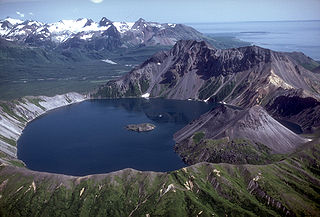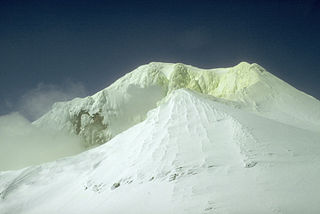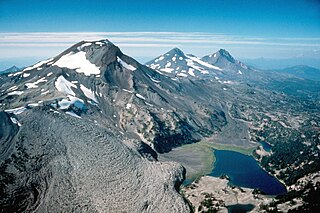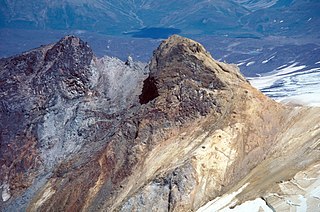
Mount Baker, also known as Koma Kulshan or simply Kulshan, is a 10,781 ft (3,286 m) active glacier-covered andesitic stratovolcano in the Cascade Volcanic Arc and the North Cascades of Washington in the United States. Mount Baker has the second-most thermally active crater in the Cascade Range after Mount St. Helens. About 30 miles (48 km) due east of the city of Bellingham, Whatcom County, Mount Baker is the youngest volcano in the Mount Baker volcanic field. While volcanism has persisted here for some 1.5 million years, the current volcanic cone is likely no more than 140,000 years old, and possibly no older than 80–90,000 years. Older volcanic edifices have mostly eroded away due to glaciation.

A fumarole is a vent in the surface of the Earth or other rocky planets from which hot volcanic gases and vapors are emitted, without any accompanying liquids or solids. Fumaroles are characteristic of the late stages of volcanic activity, but fumarole activity can also precede a volcanic eruption and has been used for eruption prediction. Most fumaroles die down within a few days or weeks of the end of an eruption, but a few are persistent, lasting for decades or longer. An area containing fumaroles is known as a fumarole field.

Novarupta is a volcano that was formed in 1912, located on the Alaska Peninsula on a slope of Trident Volcano in Katmai National Park and Preserve, about 290 miles (470 km) southwest of Anchorage. Formed during the largest volcanic eruption of the 20th century, Novarupta released 30 times the volume of magma of the 1980 eruption of Mount St. Helens.

The Valley of Ten Thousand Smokes is a valley within Katmai National Park and Preserve in Alaska which is filled with ash flow from the eruption of Novarupta on June 6–8, 1912. Following the eruption, thousands of fumaroles vented steam from the ash. Robert F. Griggs, who explored the volcano's aftermath for the National Geographic Society in 1916, gave the valley its name, saying that "the whole valley as far as the eye could reach was full of hundreds, no thousands—literally, tens of thousands—of smokes curling up from its fissured floor."

Mount Katmai is a large active stratovolcano on the Alaska Peninsula in southern Alaska, located within Katmai National Park and Preserve. It is about 6.3 miles (10 km) in diameter with a central lake-filled caldera about two by three miles in size, formed during the Novarupta eruption of 1912. The caldera rim reaches a maximum elevation of 6,716 feet (2,047 m). In 1975 the surface of the crater lake was at an elevation of about 4,220 feet (1,286 m), and the estimated elevation of the caldera floor is about 3,400 ft (1,040 m). The mountain is located in Kodiak Island Borough, very close to its border with Lake and Peninsula Borough. The volcano has caused ten known fatalities due to gas exposure.

David Alexander Johnston was an American United States Geological Survey (USGS) volcanologist who was killed by the 1980 eruption of Mount St. Helens in the U.S. state of Washington. A principal scientist on the USGS monitoring team, Johnston was killed in the eruption while manning an observation post six miles (10 km) away on the morning of May 18, 1980. He was the first to report the eruption, transmitting "Vancouver! Vancouver! This is it!" before he was swept away by a lateral blast; despite a thorough search, Johnston's body was never found, but state highway workers discovered remnants of his USGS trailer in 1993.

Mount Kaguyak is a stratovolcano located in the northeastern part of the Katmai National Park and Preserve in the U.S. state of Alaska. The 2.5 kilometres (1.6 mi) wide caldera is filled by a more than 180 m deep crater lake. The surface of the crater lake lies about 550 m below the rim of the caldera. Postcaldera lava domes form a prominent peninsula in the center of the lake. The volcano is 901 metres (2,956 ft) high and is topographically prominent because it rises from lowland areas near sea level in the south of the Big River.

Mount Martin is a stratovolcano, located on the Alaska Peninsula, United States, in Katmai National Park and Preserve. It is one of the volcanoes in the vicinity of the Valley of Ten Thousand Smokes. Mount Martin's cone stands only about 500 metres (1,600 ft) higher than the surrounding ridge. Although an eruption in 1953 is now considered questionable and no other confirmed eruptive activity has taken place at Mount Martin, there is intense fumarolic activity within its summit crater. The summit crater is also breached to the southeast. The 300 m (984 ft)-wide summit crater is often ice-free due to the geothermal heat and contains an intermittent acidic crater lake. The fumaroles in the summit crater produce extensive sulfur deposits.

The Three Sisters are closely spaced volcanic peaks in the U.S. state of Oregon. They are part of the Cascade Volcanic Arc, a segment of the Cascade Range in western North America extending from southern British Columbia through Washington and Oregon to Northern California. Each over 10,000 feet in elevation, they are the third-, fourth- and fifth-highest peaks in Oregon. Located in the Three Sisters Wilderness at the boundary of Lane and Deschutes counties and the Willamette and Deschutes national forests, they are about 10 miles south of the nearest town, Sisters. Diverse species of flora and fauna inhabit the area, which is subject to frequent snowfall, occasional rain, and extreme temperature variation between seasons. The mountains, particularly South Sister, are popular destinations for climbing and scrambling.

The Alaska Volcano Observatory (AVO) is a joint program of the United States Geological Survey (USGS), the Geophysical Institute of the University of Alaska Fairbanks (UAFGI), and the State of Alaska Division of Geological and Geophysical Surveys (ADGGS). AVO was formed in 1988, and uses federal, state, and university resources to monitor and study Alaska's volcanology, hazardous volcanoes, to predict and record eruptive activity, and to mitigate volcanic hazards to life and property. The Observatory website allows users to monitor active volcanoes, with seismographs and webcameras that update regularly. AVO now monitors more than 20 volcanoes in Cook Inlet, which is close to Alaskan population centers, and the Aleutian Arc due to the hazard that plumes of ash pose to aviation.

Operation Fiery Vigil was the Noncombatant Evacuation Operation (NEO) emergency evacuation of all non-essential military and U.S. Department of Defense civilian personnel and their dependents from Clark Air Base and U.S. Naval Base Subic Bay during the June 1991 eruption of Mount Pinatubo in the Republic of the Philippines.

This timeline of volcanism on Earth includes a list of major volcanic eruptions of approximately at least magnitude 6 on the Volcanic explosivity index (VEI) or equivalent sulfur dioxide emission during the Quaternary period. Other volcanic eruptions are also listed.
David Samuel Tucker is a geologist, author, and union organizer in Washington state. He is a research associate at Western Washington University. He was an instructor at North Cascades Institute, and the director of the Mount Baker Volcano Research Center. He writes the blog Northwest Geology Field Trips, a blog aimed at laypeople detailing where to find interesting geology in the Pacific Northwest. In 2015, he published a popular book on Washington geology, Geology Underfoot in Western Washington. He resides in Bellingham, Washington. In the 1980s he worked as a mountaineering guide in the Cascades, Mexico, and South America.
Dispersal index is a parameter in volcanology. The dispersal index was defined by George P. L. Walker in 1973 as the surface area covered by an ash or tephra fall, where the thickness is equal or more than 1/100 of the thickness of the fall at the vent. An eruption with a low dispersal index leaves most of its products close to the vent, forming a cone; an eruption with a high dispersal index forms thinner sheet-like deposits which extends to larger distances from the vent. A dispersal index of 500 square kilometres (190 sq mi) or more of coarse pumice is one proposed definition of a Plinian eruption. Likewise, a dispersal index of 50,000 square kilometres (19,000 sq mi) has been proposed as a cutoff for an ultraplinian eruption. The definition of 1/100 of the near-vent thickness was partially dictated by the fact that most tephra deposits are not well preserved at larger distances.

Alagogshak is a stratovolcano, located on the Alaska Peninsula, United States, in Katmai National Park and Preserve. It is the oldest of the volcanoes in the vicinity of the Valley of Ten Thousand Smokes. The volcano was recognized as a separate feature from Mount Martin in 1997. The Holocene Mount Martin stands partly on Alagogshak's deeply eroded edifice, about 3 kilometres (1.9 mi) northeast of the Alagogshak vent. Alagogshak was last active in Pleistocene time, and was active from about 680,000 years ago to about 43,000 years ago. The remnant summit crater consists of hydrothermally altered rock. It is the only member of the Katmai volcanic group that is no longer active.

Hannegan caldera is a 3.72 million year old volcanic collapse structure in the North Cascades of the U.S. state of Washington. The caldera collapsed during two separate volcanic eruptions that produced as much as 140 km3 of rhyolite ash.

The Cascade Volcanic Arc is a chain of volcanoes stretching from southern British Columbia down to northern California. Within the arc there is a variety of stratovolcanoes like Mount Rainier and broad shield volcanoes like Medicine Lake. But calderas are very rare in the Cascades, with very few forming over the 39 million year lifespan of the arc.
Edward Wesley Hildreth III, is an American field geologist and volcanologist employed by the United States Geological Survey (USGS). He is a fellow of both the Geological Society of America (GSA), and the American Geophysical Union (AGU). Hildreth was described as "one of the great volcanologists/petrologists of our time" in the magazine Wired.

Michelle Lynn Coombs is a geologist at the Alaska Volcano Observatory (AVO). She was the Scientist-in-Charge from 2016 to 2023. Coombs is a fellow of the Geological Society of America.
















